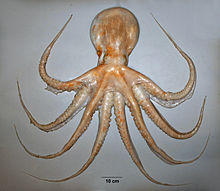Enteroctopus zealandicus
| Yellow octopus | |
|---|---|

| |
| Enteroctopus zealandicus. Photo by Darren Stevens, NIWA | |
| Scientific classification | |
| Domain: | Eukaryota |
| Kingdom: | Animalia |
| Phylum: | Mollusca |
| Class: | Cephalopoda |
| Order: | Octopoda |
| Family: | Enteroctopodidae |
| Genus: | Enteroctopus |
| Species: | E. zealandicus
|
| Binomial name | |
| Enteroctopus zealandicus (Benham, 1944)
| |

| |
| Range of Enteroctopus zealandicus | |
| Synonyms | |
| |
Enteroctopus zealandicus, also known as the yellow octopus, is a large octopus of the genus Enteroctopus. It is endemic to the waters surrounding New Zealand.
Description
Enteroctopus zealandicus has the distinctive characteristics of the genus Enteroctopus, including longitudinal folds on the body and large paddle-like papillae. E. zealandicus is a large octopus, reaching a total length of at least 1.4 m,[1] though few whole samples have been collected and this is only a guide.
Range and habitat
Enteroctopus zealandicus is endemic to New Zealand. Samples have been collected along the east coast of the south island, Chatham Rise, Campbell Plateau, Stewart, Auckland and Antipodes Islands; and from the surface down to 530m depth.[1] There is an absence of published information about the preferred habitat or diet of this species.
Predators
Enteroctopus zealandicus is one of the most important prey of New Zealand sea lions at the Auckland Islands and Campbell Island, in the New Zealand Subantarctic.[2][3][4] It has also been identified from beaks found in the gut of beached whales.[5]
References
- ^ a b O'Shea, S. (1999). "Octopoda (Mollusca: Cephalopoda)". NIWA Biodiversity Memoir. 112, New Zealand.
- ^ Childerhouse, S (2001). "Diet of New Zealand sea lions at the Auckland Islands". Wildlife Research. 28: 291–298. doi:10.1071/wr00063.
- ^ Meynier, L (2009). "Variability in the diet of New Zealand sea lion (Phocarctos hookeri) at the Auckland Islands, New Zealand". Marine Mammal Science. 25: 302–326. doi:10.1111/j.1748-7692.2008.00252.x.
- ^ Roberts, J; Lalas, C (2015). "Diet of New Zealand sea lions (Phocarctos hookeri) at their southern breeding limits". Polar Biology. 38: 1483–1491. doi:10.1007/s00300-015-1710-3.
- ^ "Story: Octopus and squid". Te Papa. Retrieved 9 Oct 2015.
